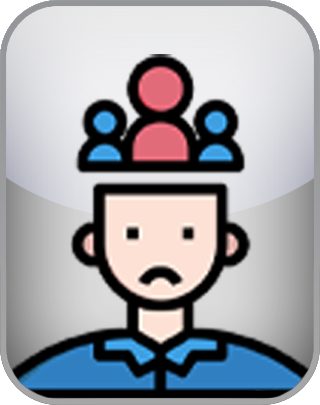Academically reviewed by Dr. Sabina Alispahić, Ph.D., professor of psychology
Social Phobia Test (SPT)
The Social Phobia Test, derived from the Social Phobia Scale (SPS) developed by R. Mattick and J. Clark (1989) serves as a valuable tool for assessing personality traits related to social anxiety. This instrument is designed to identify behavioral and emotional patterns that may influence interpersonal interactions, emotional well-being, and daily functioning. Rather than focusing on diagnostic labels, the test aims to facilitate self-assessment and provide insights into the underlying factors shaping individual experiences. It offers a structured approach to understanding the dynamics of social behavior and its impact on various aspects of life.
To take the test, enter your input below.
Question 1 of 20
I become self-conscious when using public toilets.
| Disagree | Agree |
NEXT
The IDRlabs Social Phobia Test was developed by IDRlabs, based on the Social Phobia Scale (SPS).
Social phobia, also known as social anxiety disorder, is a mental health condition characterized by an intense and persistent fear of social situations. Individuals with this condition often worry excessively about being judged, embarrassed, or humiliated in front of others. Common scenarios that trigger this fear include public speaking, meeting new people, or participating in group activities. This fear can be so overwhelming that it disrupts daily life and interferes with relationships, work, or school.
The symptoms of social phobia go beyond mere shyness. Physical manifestations such as sweating, trembling, rapid heart rate, or stomach discomfort often accompany the anxiety. People with social phobia may also experience cognitive symptoms like racing thoughts or a heightened awareness of their actions. Behavioral symptoms include avoiding social situations altogether or enduring them with significant distress. These reactions can be debilitating, making even routine interactions a source of severe discomfort.
The causes of social phobia are multifactorial, often involving a combination of genetic, environmental, and psychological factors. A family history of anxiety disorders can increase susceptibility, while negative past experiences, such as bullying or social rejection, may contribute to its development. Additionally, individuals with certain personality traits, such as perfectionism or a strong fear of criticism, may be more prone to social anxiety.
Treatment for social phobia typically includes therapy, medication, or a combination of both. Cognitive-behavioral therapy (CBT) is highly effective, as it helps individuals identify and challenge negative thought patterns while gradually exposing them to feared situations in a controlled manner. In some cases, medications like selective serotonin reuptake inhibitors (SSRIs) can help manage symptoms by reducing anxiety levels. Lifestyle changes, such as practicing relaxation techniques, regular exercise, and maintaining a healthy sleep routine, also play a supportive role in managing the condition.
Social phobia is a manageable condition, and early intervention is key to improving outcomes. With proper support and treatment, individuals can build confidence, reduce their fears, and lead fulfilling lives. Raising awareness about social phobia helps reduce stigma, encouraging those affected to seek help and take the first step toward recovery.
As the publishers of this free test, which allows you to screen yourself for social phobia, we strived to make the test as reliable and valid as possible by subjecting this test to statistical controls and validation. However, free online quizzes such as the present test do not provide professional assessments or recommendations of any kind; the test is provided entirely “as-is.” For more information about any of our online tests and quizzes, please consult our Terms of Service.
References
- Mattick, R. P., & Clarke, J. C. (1998). Development and validation of measures of social phobia scrutiny fear and social interaction anxiety. Behaviour Research and Therapy, 36(4), 455–470.
- Peters, L. (2000). Discriminant validity of the Social Phobia and Anxiety Inventory (SPAI), the Social Phobia Scale (SPS), and the Social Interaction Anxiety Scale (SIAS). Behaviour Research and Therapy, 38(9), 943–950.

